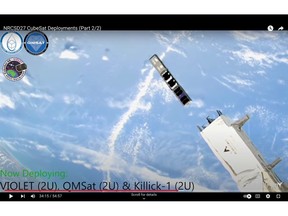New Brunswick's first satellite won't phone home
Researchers say satellite was successfully sent into orbit, but is not yet transmitting radio signals

Article content
New Brunswick’s first space satellite has reached orbit, but isn’t returning calls.
VIOLET, one of 14 satellites taking part in the Canadian Space Agency’s Canadian CubeSat project, was launched into the Earth’s orbit on April 18 from the International Space Station.
Since then, the researchers at the University of New Brunswick in Fredericton behind the satellite’s launch, have been trying to make their first radio contact, but so far VIOLET isn’t answering.
Brent Petersen, a co-principal investigator and professor of electrical and computer engineering at UNB, said after exhaustive research they believe VIOLET’s antennae did not deploy as planned after deployment.
VIOLET is about the size of a loaf of bread, measuring 10x10x20 centimetres, with two antennae attached at the corners of the satellite on a spring.
Petersen said a wire mechanism, like the coils inside a toaster, was supposed to heat up and melt two small wires, which were installed to hold the antennae down during the satellite’s deployment.
The researchers suspect the wire, an eight-pound fishing line, did not in fact melt, which would mean the antennas did not deploy into space. He said both have to be in place for communication to happen.
Petersen says not all is lost, and if the heater wires didn’t melt the fishing line, it “will degrade due to vacuum, heat and ultraviolet.”
The team expects the wire will be gone in the next couple of weeks and the antennae will “flip into place,” finally allowing contact with their lost satellite.

Petersen said more than 300 people, including 274 engineering students from the University of New Brunswick, Université de Moncton and the New Brunswick Community College in Saint John, have been involved since 2018 in building the satellite.
The UNB team is responsible for the controlling and communication phases of the satellite, and will conduct the experiments and troubleshoot any software or technical challenges.
VIOLET travelled on a Falcon 9 rocket from NASA to the International Space Station in early March and is named after New Brunswick’s provincial flower.
The two-kilogram satellite was deployed into low orbit, or about 400 kilometres above the surface of the Earth, circling the planet once every 92 minutes, where researchers hope it will remain until it burns up in three to six months.
The work was guided and funded by the Canadian Space Agency at a cost of about $200,000. Another $200,000 was granted by the New Brunswick Innovation Foundation.











Postmedia is committed to maintaining a lively but civil forum for discussion. Please keep comments relevant and respectful. Comments may take up to an hour to appear on the site. You will receive an email if there is a reply to your comment, an update to a thread you follow or if a user you follow comments. Visit our Community Guidelines for more information.